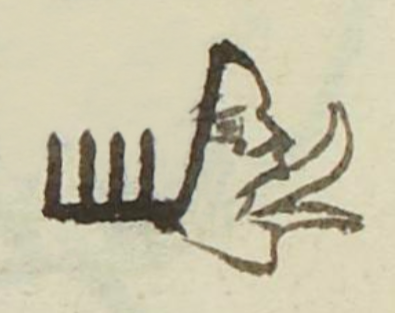Nauhecatl (MH614r)
This black-line drawing of the simplex glyph plus notation for the personal name Nauhecatl (or Nahui Ehecatl, "4-Wind," attested here as a man’s name). This is a calendrical name, given that Ehecatl is a day sign in the tonalpohualli (divinatory calendar). We are retaining the spelling of Ehecatl as Ecatl here, awaiting further analysis. The notation of four is shown as four upright lines that are connected at the bottom with a horizontal line. This horizontal line also connects to the anthropomorphic head with a beak-like wind-blowing device in the mouth. The head is facing toward the viewer's right.
Stephanie Wood
John Montgomery drew a group of wind glyphs (possibly mainly Mixtec), showing the variety of ways the blowing device might look. It is published in FAMSI, Inc.
Stephanie Wood
1560
Jeff Haskett-Wood

nahui, four, https://nahuatl.wired-humanities.org/content/nahui
eca(tl), breath or air, https://nahuatl.wired-humanities.org/content/ecatl
eheca(tl), wind, https://nahuatl.wired-humanities.org/content/ehecatl
Cuatro Viento, 4-Viento
Stephanie Wood
Matrícula de Huexotzinco, folio 614r, World Digital Library, https://www.loc.gov/resource/gdcwdl.wdl_15282/?sp=310st=image.
This manuscript is hosted by the Library of Congress and the World Digital Library; used here with the Creative Commons, “Attribution-NonCommercial-ShareAlike 3.0 License” (CC-BY-NC-SAq 3.0).



